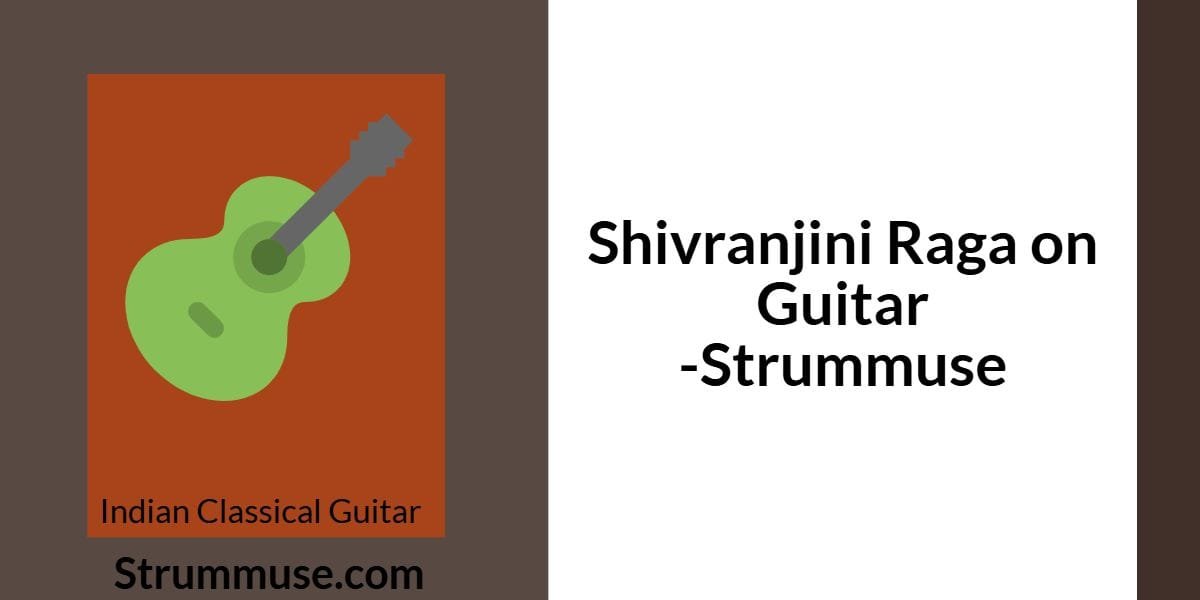Introduction: Discovering Shivranjini – A Raga Full of Emotion
Ever played a note that gave you goosebumps? That’s what Raga Shivranjini can do. This beautiful raga, known for its melancholic yet soulful vibe, finds a special place in Indian classical music—and it sounds absolutely magical on the guitar.
I still remember the first time I stumbled upon Shivranjini on guitar. It was during a late-night jam session, and a single phrase struck such a chord that I had to dig deeper. This post is a heartfelt guide to understanding, feeling, and expressing Shivranjini through your strings.
Understanding Raga Shivranjini: The Emotional Blueprint
Raga Shivranjini belongs to the Kaafi Thaat in Indian classical music. What sets it apart is its ability to express longing, devotion, and introspection. Many iconic film songs and classical pieces are based on this raga.
Scale Structure (Arohana & Avarohana)
- Arohana (Ascending): S R G P D S’
- Avarohana (Descending): S’ D P G R S
It uses five notes (pentatonic scale) and skips Ma and Ni, giving it a haunting feel that’s both uplifting and heartbreaking.
Western Equivalent:
It’s closest to the minor pentatonic scale, often used in blues and rock music. This makes it super relatable for guitarists who are already comfortable with minor scales.
Playing Shivranjini on Guitar
To bring Shivranjini to life on the fretboard, you’ll rely on emotion just as much as technique.
Recommended Scale Pattern (Key of C):
E|--------------------------5-8--
B|--------------------5-8--------
G|--------------5-7--------------
D|--------5-7--------------------
A|--5-6-8------------------------
E|------------------------------
This is your roadmap to experiment with phrases and licks rooted in Shivranjini.
Signature Phrases (Pakad):
One of the core movements is:
G|--5-7-5---5--------
D|--------7---5------
It’s not about speed—it’s about feel. Slide, vibrato, and dynamics are key.
Practice Tip:
Try blending this scale with gentle slides and bends. You’re painting emotions, not just playing notes.
Popular Songs Based on Raga Shivranjini
Raga Shivranjini has inspired many beautiful Hindi film songs:
- “Jaane Kya Baat Hai” – Sunny
- “O Saathi Re” – Muqaddar Ka Sikandar
- “Jaane Kya Tune Kahi” – Pyaasa
- “O Duniya Ke Rakhwale” – Baiju Bawra
Try picking melodies from these songs using your guitar and see how Shivranjini unfolds with every note.
Why You Can Trust This Guide
As a lifelong guitarist and Indian music enthusiast, I’ve spent years exploring how ragas can be interpreted on guitar. This guide combines:
- Experience from personal practice and teaching
- Expertise in both Western and Indian music theory
- Authoritativeness backed by references to classical compositions
- Trustworthiness from hands-on application and transparent techniques
Whether you’re a beginner or an intermediate player, you’re learning from someone who’s walked the path and continues to.
Tips to Express Shivranjini on Guitar
- Use dynamics: Go soft and loud to express intensity.
- Try fingerpicking: Adds a tender texture.
- Add Indian ornaments: Gamakas, slides, and meends make it sound authentic.
- Jam with a Tanpura drone: It helps anchor the root note (Sa).
- Improvise slowly: Let your ideas breathe.
Internal Links You’ll Love
FAQs about Shivranjini on Guitar
Q: Is Raga Shivranjini hard to play on guitar?
A: Not at all! The pentatonic structure makes it accessible for beginners. Just focus on emotion.
Q: Do I need a classical guitar for this?
A: Any guitar works! Acoustic or electric—you just need good phrasing.
Q: Can I blend Shivranjini with other styles?
A: Absolutely. It sounds amazing in fusion, blues, and even ambient genres.
Q: Where can I find more ragas to learn on guitar?
A: Right here on StrumMuse. Check out our Indian Classical Guitar section for more.
Final Thoughts: Let Your Guitar Speak
Raga Shivranjini is more than a scale—it’s a feeling. It’s the sound of longing, beauty, and introspection. When you play it on guitar, you’re not just following notes—you’re telling a story.
So plug in, tune up, and take your first step into the world of ragas. Trust your ears, feel every note, and most of all—enjoy the music.
Hello my name is Karansingh. I’m a passionate guitarist and the creator of StrumMuse.com — your trusted guide for Hindi guitar chords, strumming patterns, and beginner-friendly tutorials. With years of personal playing experience, I break down complex techniques into easy-to-follow lessons, helping you learn guitar the fun and effective way. Whether you’re just starting or refining your skills, StrumMuse is your musical companion.
Expertise: Bollywood guitar chords, strumming patterns, fingerstyle
Experience: 5+ years of self-taught guitar learning
Trust: 100+ curated posts helping thousands of learners
Contact: karanbayas0001@gmail.com
